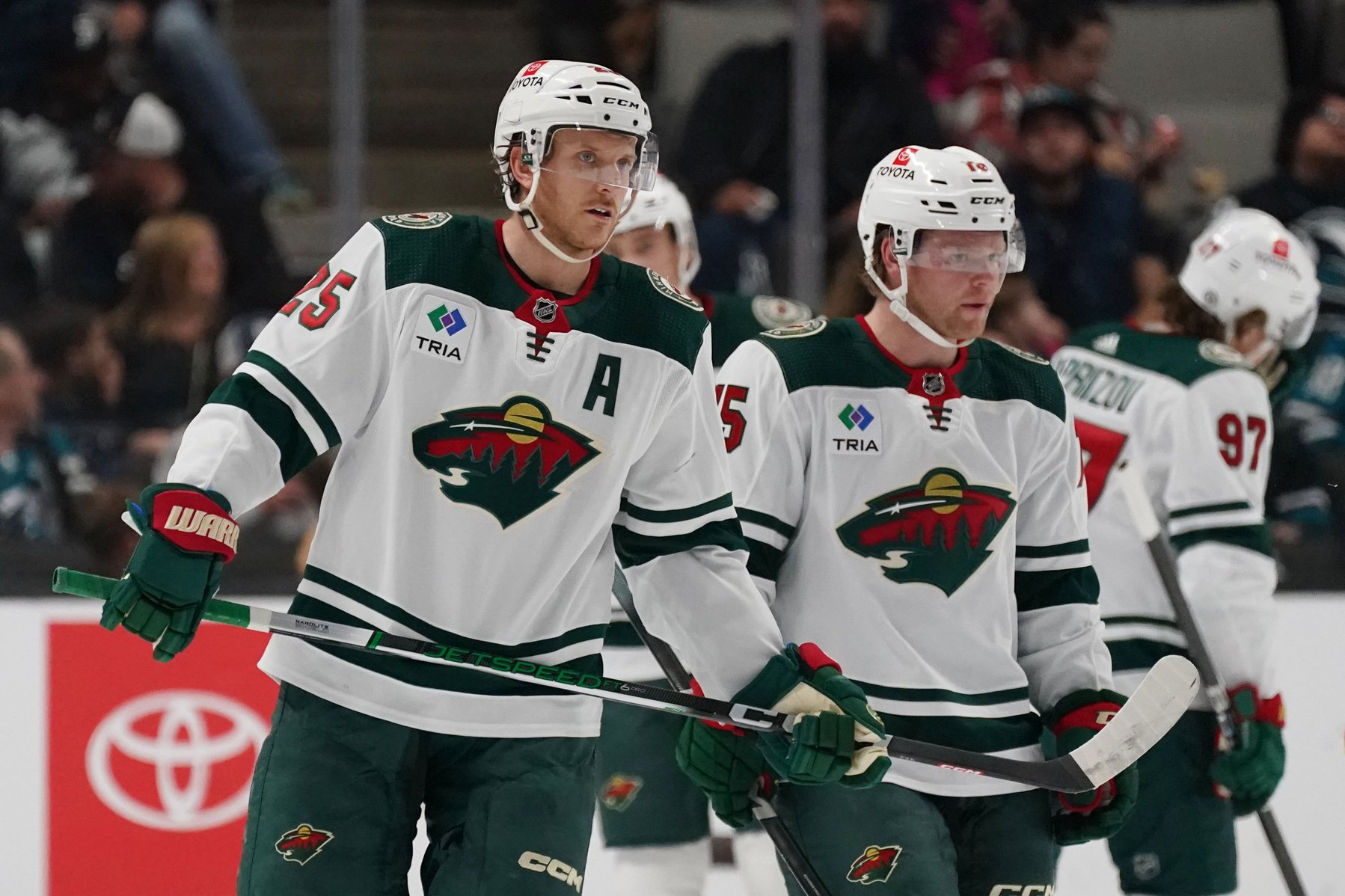
One of hockey’s most treasured and time-tested tropes is that special teams can make or break a team. A good power play or penalty kill has proven to be an excellent weapon for hockey's great teams. However, a bad special teams unit can sink a season.
In 2023-24, the Minnesota Wild had one of the worst penalty kills in the NHL, ranking third worst in penalty-killing percentage. With a rate of just 74.52% successful kills (67 goals against total), the team all but guaranteed they'd be giving up an average of around one special teams goal per game.
We all know the Wild's poor penalty-killing was disastrous for the team in 2023-24, but let's dive deeper. How did the Wild perform so poorly? What factors contributed to their poor performance? Are there any reasons to believe they can turn it around in 2024-25?
What Went Wrong For Wild
Let’s start where things went wrong in 2023-24. Penalty-killing goaltending was a weakness for the Wild, especially when Marc-André Fleury was in net. Fleury played 40 games for the Wild and racked up the second-worst goals saved above expected (-8.8) in the league. With a -.026 save percentage above expected, Fleury performed poorly 4-on-5 independently of the quality of chances the team gave up.
All that said, the quality of chances the Wild give up short-handed is a considerable problem. Looking at the Wild’s PK shot map from last season, their most glaring weakness becomes evident. The team doesn’t limit shots from high-danger areas.
Shot Maps provided by Hockeyviz.com.

The Wild allowed a much higher number of shots than average from the most dangerous areas of the ice. Instead of pushing shots to the outside or from tight angles, Minnesota’s opponents feasted on them in the slot and front of the net.
The high circle is one of the few areas where the Wild limits shots. That may be a great strategy if you’re trying to stop Alexander Ovechkin’s power play setup. However, the rest of the league is trying to run their offense in the areas Minnesota struggled at defending.
The Wild’s penalty kill struggles become even more obvious when you compare their shot maps against teams that were highly successful killing penalties last season.
Comparison To Top PKs

Above are the shot maps for the top three penalty-killing teams in the league: the Carolina Hurricanes, the Los Angeles Kings, and the New York Rangers. Minnesota can learn crucial lessons from examining how the best penalty-killing teams in the league operate.
Carolina and the Rangers are very effective at limiting shots, especially in the slot and middle of the ice. In contrast, the Kings did a great job limiting shots directly in front of the net but allowed many chances from tight angles on the sides of the goal mouth.
The three teams do things differently but share one modus operandi. They allow shots from concentrated, often low-danger areas. The teams know where chances will come from in high quantities, making defending it easier. The Hurricanes, Kings, and Rangers have designed their penalty kills to push teams to specific areas. On the other hand, the Wild have multiple areas of the ice where they allow high-danger chances.
Learning from Past Success
We can acknowledge that the Wild penalty kill was porous in 2023-24, but it hasn’t always been that way. Minnesota has struggled with its special team consistency for years. Still, the 2022-23 season represented a high point. The Wild successfully killed 82.03% of penalties that year, good for 10th in the league. Examine the shot maps from the 2022-23 season, and it’s easy to see why the results differed.
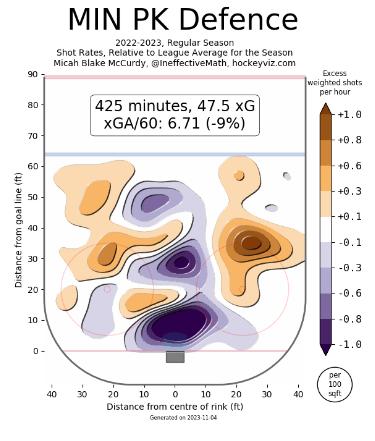
The Wild dominated the middle of the ice and pushed their opposition to the boards. The shot maps from 2022-23 and 2023-24 are nearly exact opposites in many ways. What contributed to such a stark contrast in results from year to year?
Key Pieces Missing
Personnel is one of the most noticeable differences between the penalty kills between 2022-23 and 2023-24. The easiest way to illustrate the lack of consistency between years is by looking at the hockeyviz.com presence and importance charts.
The chart shows the number of minutes a player plays in a specific situation throughout the season. When you look at the Wild’s PK presence and importance chart from 2022-23 to 2023-24, the penalty kill’s lack of consistency becomes obvious.
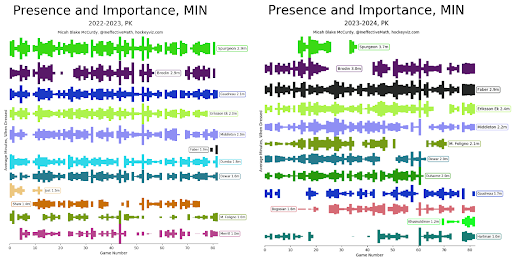
Long-time penalty contributor Matt Dumba is no longer on the team after playing on the team’s penalty kill for years. Mason Shaw was a penalty kill specialist and missed nearly the 2023-24 season with an injury. Shaw’s absence was felt on special teams in 2023-24 and will continue to be now that he signed with the Winnipeg Jets.
Along with Dumba and Shaw, two players no longer in the organization, two of the Wild’s most essential players also missed significant time in 2023-24.
Jonas Brodin played in 62 games but suffered several injuries throughout the year. Brodin also missed time in 2022-23, so having him for a full season would be beneficial. Jared Spurgeon missed even more time, playing in only 16 games. Spurgeon played the most penalty kill minutes of his career in 2022-23 with 234.3 minutes on the PK.
With Spurgeon’s return and a clean bill of health for Brodin, some of that consistency will return next season.
Can the Wild Turn the PK Around?
As mentioned, the Wild should have much more consistency next year. Hopefully, Brodin and Spurgeon will return and play meaningful minutes on the penalty kill. Brock Faber will continue to play a crucial role for the unit but should improve after playing a full season.
The WIld also signed one of the league’s premiere penalty killers, Yakov Trenin, this offseason. There’s been much discussion about whether Trenin is an excellent signing, but he’ll almost certainly help out on the penalty kill.
Minnesota’s special teams were better under John Hynes last season than Dean Evason. Penalty-killing was an especially strong area for the team immediately after hiring Hynes. The Wild still didn’t perform well enough, but perhaps the team will benefit from a full season under Hynes.
Concerns remain, of course. For example, Spurgeon and Brodin should start the year healthy, but they’re on the wrong side of 30. If any more injuries occur or declines occur from key players, the Wild could just as quickly find themselves having special team woes again.
Still, the Wild simply must perform better on the penalty kill. They’re not going anywhere without better special teams. They should be better positioned to see that success with key pieces in place this season.
Think you could write a story like this? Hockey Wilderness wants you to develop your voice, find an audience, and we'll pay you to do it. Just fill out this form.
-
 3
3
-
 2
2



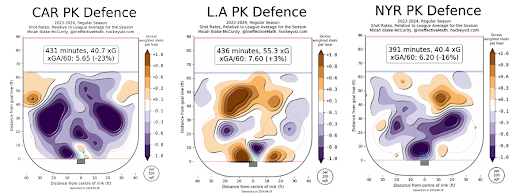
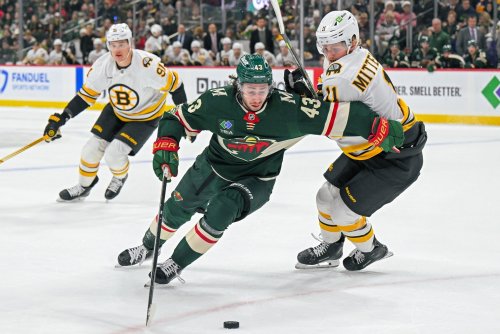



Recommended Comments
Join the conversation
You can post now and register later. If you have an account, sign in now to post with your account.
Note: Your post will require moderator approval before it will be visible.